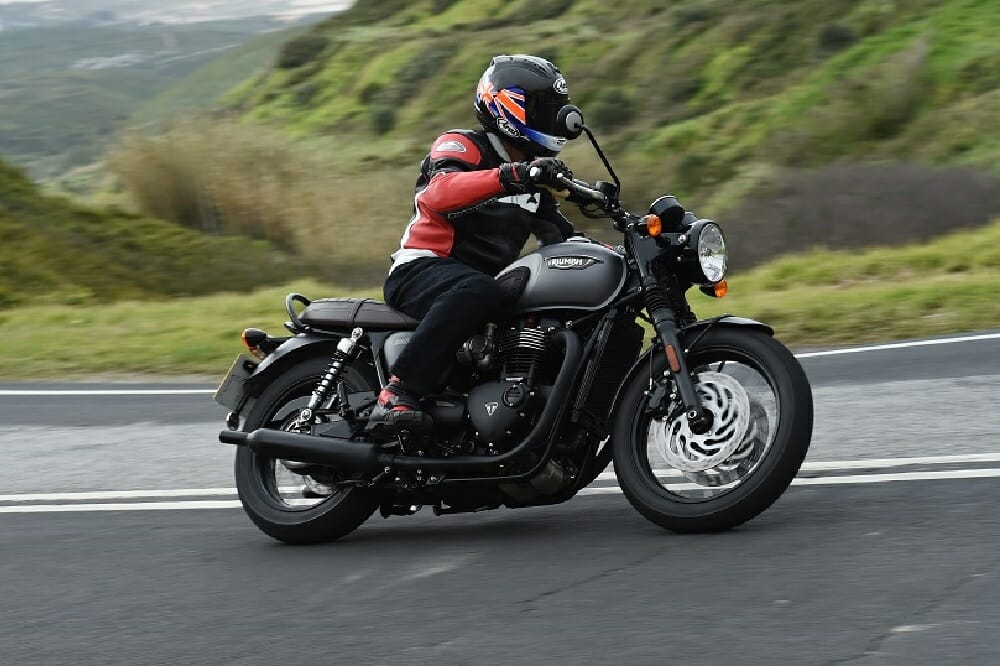
Photography by Alessio Barbanti and Matteo Cavadini
There’s been a succession of new Triumph models for 2016, but so far they’ve all been Euro 4 compliant updates of existing models—Speed Triple, Explorer 1200, the forthcoming Tiger Sport and even the 900 Street Twin, which is essentially Triumph’s redefined entry level model to the Bonneville family.
But now to celebrate the 60th anniversary of Johnny Allen’s September 1956 achievement of setting a new two-wheeled World Land Speed record at 214.40 mph on the Bonneville Salt Flats, in the so-called Texas Ceegar streamliner powered by a twin-cylinder 650cc Triumph motor, the first all-new Triumph model platform for quite some time has finally made it to the marketplace, after being unveiled at Milan’s EICMA Show last November.
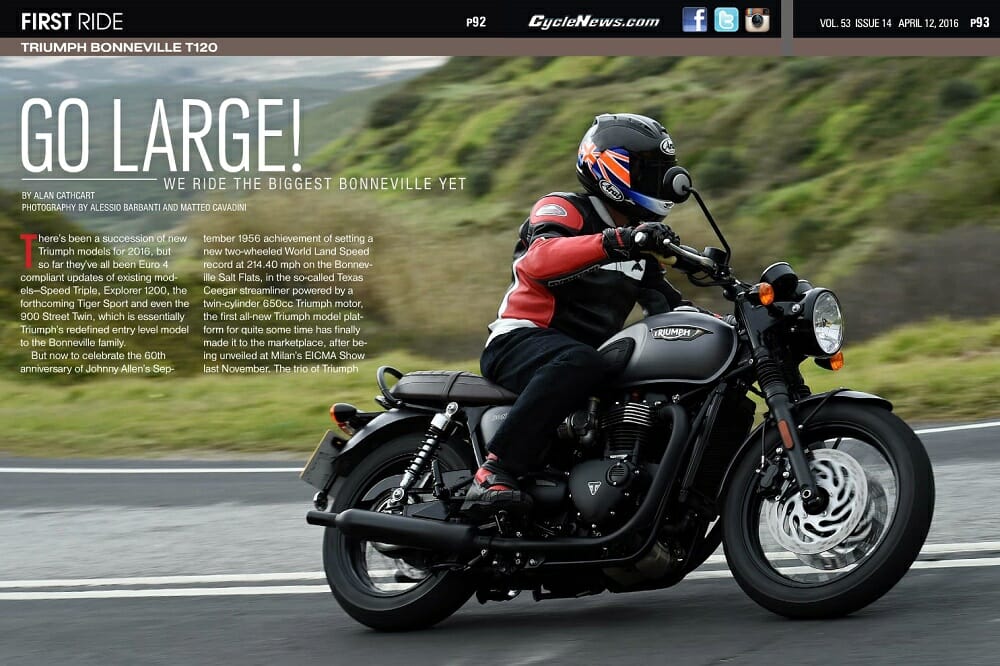
The trio of Triumph factories in Thailand are now cranking up production of the two quite different variants of the largest-capacity Bonneville platform ever to reach the marketplace, powered by an all-new liquid-cooled 1197cc eight-valve parallel-twin engine with 270° crank and chain-driven single overhead cam, measuring 97.6 x 80mm. In so-called HT—as in High Torque—T120 form this produces 79bhp/59kW at 6,550 rpm, with maximum torque of 105Nm as low as 3,100 rpm—54% more than the outgoing T100 model—with a much broader midrange spread of grunt. This compares with the higher compression (11:1 versus 10:1 for the T160) so-called “High Power” Thruxton guise in which it delivers 96bhp/72 kW at 6,750 rpm, and peak torque of 112Nm at 4,950 rpm, with both variants of the motor redlined at 7,000 rpm. Yet in T120 guise the new 38-percent bigger engine is claimed to give 13-percent better fuel economy than the 865cc T100 model, previously the largest capacity Bonneville engine. So, less with more.

With the new T120 model Triumph is specifically aiming to recapture the look and feel of the original 1959 Bonneville street bike carrying the same designation, which was supposed to suggest that it could do 120 mph, whereas the most favorable magazine road tests back then saw it top out at 108 mph! But the all-new 2016 parallel-twin that’s certain to be able to more than live up to its name in terms of speed recaptures the original Bonneville’s appearance totally authentically, complete with optional two-tone fuel tank—either red/silver or black/white—versus the red or black single-color base model or the T120 Black variant. The throttle bodies look like carburetors, and the cylinders have machined fins that according to Triumph actually do aid cooling, so the water radiator now fitted can be small enough to be visually insignificant, tucked away behind the front mudguard with barely a hose in sight. The brushed aluminum engine cases have copious period-shaped inspection covers covered in chrome, unless you go for the T120 Black variant, which instead has matt black everywhere offset by a distinctive brown seat, though the one I rode at the press launch held in Portugal had a “Matt Graphite” gunmetal fuel tank. To each his own.
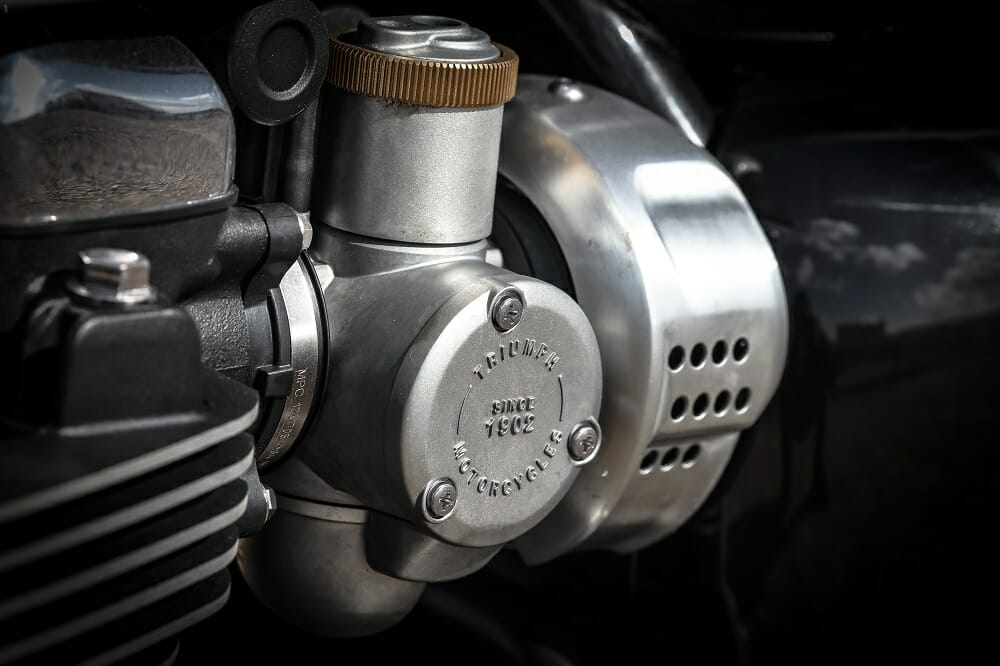
That seat is a very untiring place to be on the T120, thanks to the complete lack of vibration at any revs from the all-new parallel-twin motor with 270° crank and twin balance shafts, up to and including the 7,000 rpm redline that you honestly have no right ever finding. The fuel tank is well shaped, so you grasp it cozily with your knees, plus the retro-looking round mirrors give a good view, and don’t vibe. With its greater low down grunt and extra midrange torque provided by its heavier crank delivering greater inertia, you end up glad that Triumph has given you traction control as standard, since as soon as you open the throttle in bottom or second gear you get a strong shove that snaps the bike forward quite fiercely. Maybe Triumph engineers felt they had to get the show on the road early via some quite aggressive fuelling, but really, with this much torque on tap it’s rather unnecessary. In the other gears it isn’t an issue, with a much smoother pickup from a closed throttle, and with so much midrange poke there really isn’t any need to go hunting for the redline. Keeping the engine in its happy zone between 3,000-5,500 rpm will deliver a lovely luscious liquid pull, and even when you rev it closer to the 6,550 rpm peak power mark it still feels quite unstressed, delivering relaxed and effortless but decidedly muscular forward progress thanks to the extra cubes. Triumph’s iconic Bonneville model finally goes large!
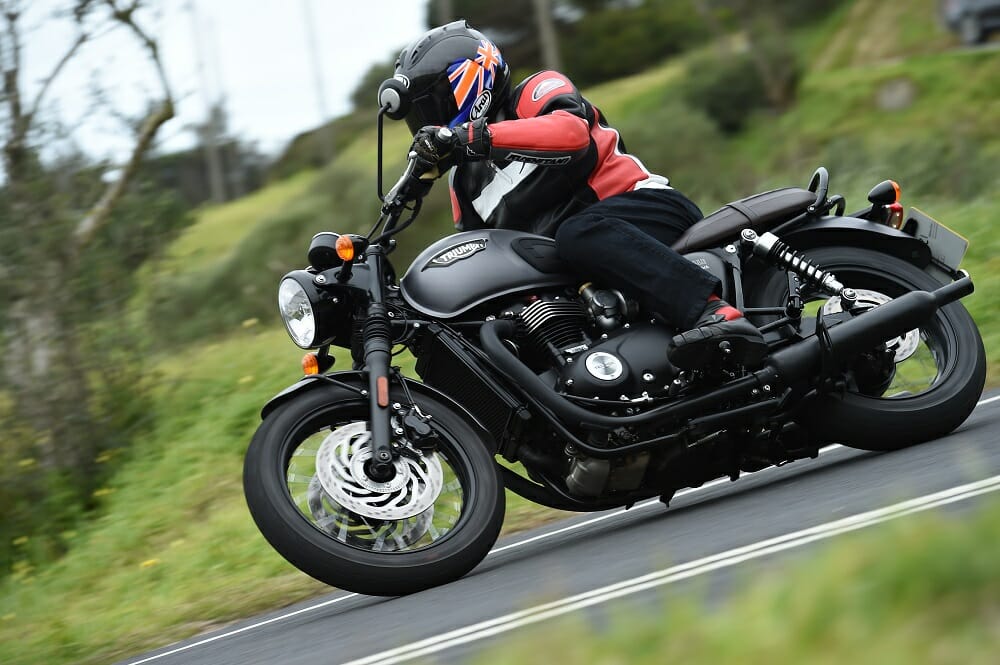
The retro-looking twin clocks each have a digital panel whose info can be scrolled through via the button on the left-hand handlebar with I-for Info on it, and one on the right with an M-for-Mode on the right ‘bar. The I-button accesses current and average fuel consumption, range to empty and a gear indicator, while the M-button is the entry card to the new maxi-Bonneville’s very non-vintage era electronics package. The T120 has ABS as standard (as required for Euro 4) along with TC, both single-stage and switchable, and offers two riding modes via the Keihin ECU, Road and Rain. Rain mode offers the same peak power but delivers less torque in response to a given throttle input, so has a less aggressive throttle response in the lower gears, good for damp roads even with the TC, as well as riding in city streets and/or in slow-moving traffic. In Road mode the drive still comes in smoothly but even more strongly as you roll the throttle open, and switching modes on the move is a simple business—just close the throttle, press that button and then pull in the clutch to confirm the swap. Worth noting you must also pull in the clutch to start the T120, even in neutral, and the clutch action is extremely light, denoting the presence of Triumph’s so-called ‘slip assist’ design, which is their version of a slipper clutch, though with more engine braking left in than is normal with one of those.
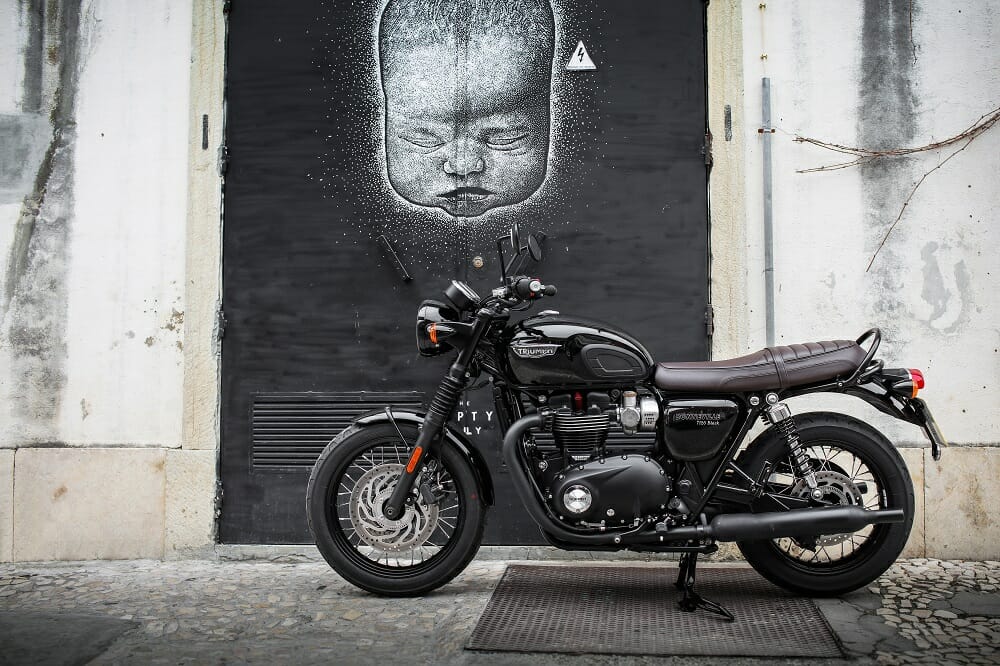
Also worth noting is the very comfortable but quite upright riding position—call it a real world stance—complete with rubber knee pads on the side of the traditional-shaped fuel tank that you do find yourself using to get a purchase to aid changing direction. However, the low footrests that are positioned a little further forward of the seat have hero tabs on them which grind on the tarmac at only moderate angles of lean which the Pirelli Phantom Sportscomp tires specifically designed for the T120 are well capable of reaching, and do inhibit turn speed if you decide you’d like to attack a sinuous stretch of curves in something approaching anger. Get ready for your feet to be bounced up and down on the folding footrests when that happens—and it will to riders of even relatively little experience—to a background soundtrack of metal being ground away. I’d take an angle grinder to the metal tabs as soon as I got the bike home if it were mine. Better though are the handlebar grips, which are thicker and chunkier and more satisfying to hold on to than the thinner ones on the Thruxton. That’s because there are heated grips as standard on the T120, controlled by a button on the left-hand handlebar grip, and they’re pretty good, and although there’s only two levels that’s all you need—level two was too hot to use on a cool Portuguese summer’s day in the hill country inland from Lisbon where we rode the new Triumph maxi-twins, but level one did the job well.
As on the Street Twin 900 I rode before Christmas, the Kayaba suspension on the T120 is brilliantly set up, with the non-adjustable 41mm cartridge fork and twin rear shocks with adjustable spring pre-load only delivering 4.7 inches of wheel travel at each end. Once again Triumph’s chassis development gurus Felipe and David Lopez (yes, they’re brothers) have done an excellent job in teaming with Kayaba’s technicians to produce a twin-shock motorcycle with pre-chosen suspension damping front and rear which has a level of compliance that’s worthy of a much more expensive and sophisticated variable-rate monoshock bike. I was once again seriously impressed by the way the Triumph ate up the bumps—it’s as good as if the company had monoshocked the bike. The seat is also generously padded, soft and comfortable—Triumph says it’s got more foam than the previous T100 Bonneville had, while seat height remains accessible for shorter riders at 785mm. Build quality seems very good, reflecting well on Triumph’s Thai operation.
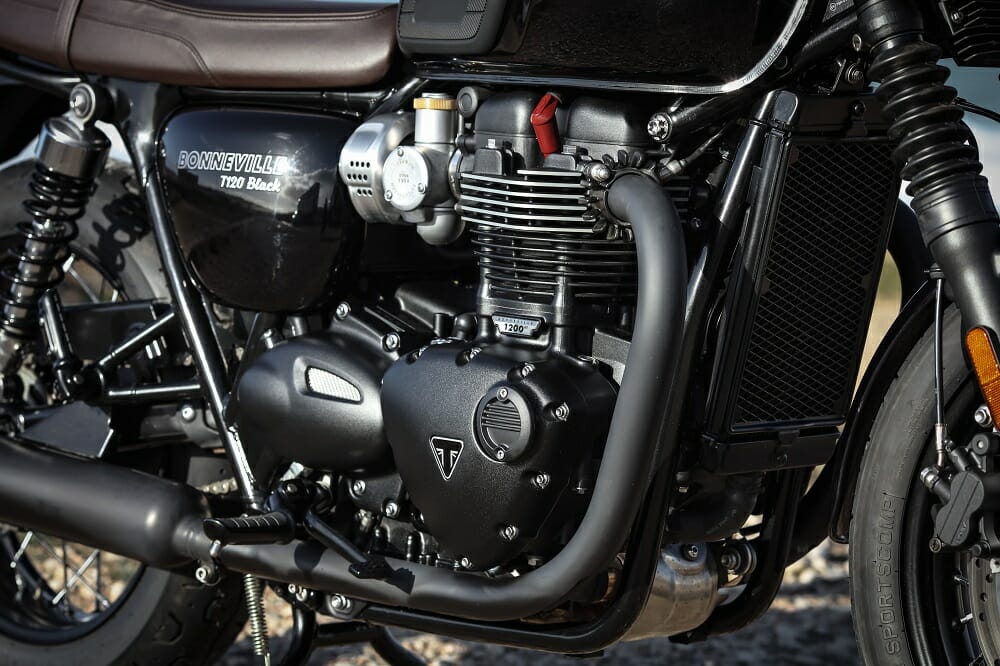
The T120 shares the same tubular steel main frame with the Thruxton/R, but with a different welded-on sub-frame and delivers a quite different feel to its sporty sister, which also has an aluminum swingarm compared to the T120’s box-section steel one which is also 30mm longer, resulting in a that much longer 56.9-inch wheelbase compared to the Thruxton. Thanks to its higher-set one-piece handlebar and the 18-inch front wheel the handling is a little more remote, since you don’t get the same feedback from the front tire as you do via the Thruxton R’s 17-inch front end and its lower-mounted clip-ons. Alongside longer wheelbase, the T120’s steering geometry is quite conservative, with a 25.5° fork rake and 4.1 inches of trail. For a twin-cylinder naked roadster it’s also somewhat on the porky side with its claimed 493-pound dry weight, although it really doesn’t feel as heavy as that figure suggests. It does have a low center of gravity, which aids flicking it from side to side along a winding country road, and also helps it ride bumps better where even the superb suspension setup might suffer some strife. The T120 seems lighter than that on the move—and anyway the brakes felt well up to the task of hauling such a weight down quickly and capably from high speed, with the twin 310mm Sunstar front discs and single 255mm rear all gripped by Nissin twin-piston calipers that proved quite capable of doing their job, with progressive power and good modulation via the adjustable lever.

The new Bonneville T120 isn’t a retro-styled bike given a dose of modern performance, like its Thruxton R sister. Instead, it’s a modern recreation of a famous classic motorcycle, employing current technology in pursuit of today’s performance and durability, coupled with the allure of yesteryear. It’s got a centerstand as standard, service intervals have now been increased to 10,000-mile (from 6,000 miles), it has an overdrive sixth gear which I never really used during our morning’s ride which kept us away from dual highways, the ignition lock has been moved to the correct place between the handlebar and clocks, and it’s got LED lights, a gear selected indicator, and even a USB charging socket. Yet the T120 also has a genuine period feel via the trademark Bonneville styling, all the shiny covers, the fact the radiator is completely hidden away, and those rubber tank grips on the sides of the tank. Check out the retro-style clocks, the 32-spoke wire wheels and their chrome rims, the “Triumph” embossed handlebar clamp, and the numerous other detail design cues from all the company’s yesterdays that Triumph’s stylists must have had a great time researching. Listen to the engine note issuing from those double-skinned peashooter silencers that’s loud enough to convince you it’s coming from an air-cooled motor, and don’t then try to tell me this new “big” Bonneville isn’t history once more. With prices starting in the UK from GBP 9,600 inc. 20% tax, the Bonneville T120 is quite a bit less expensive than the best-selling GBP 11,900 BMW RnineT, and is essentially the bike that Ducati should have produced by now as the 1200cc variant of their Scrambler family—the two-thirds as big 800cc variant of the Scrambler priced from GBP 7,250 upwards has minimal performance pretensions.
Mind you, customers for any retro-styled Triumph Bonneville—especially one as faithfully concocted as the T120, and with its meaty maxi-sized motor—will be seeking a bike with the sporting allure and performance heritage it brings with it, rather than being inspired to catch the wind and buy a Scrambler as an entry ticket to the flower power Land of Joy. Triumph vs. Ducati, Bonneville vs. Scrambler—it’s Mods and Rockers all over again, but in a 21st century context!
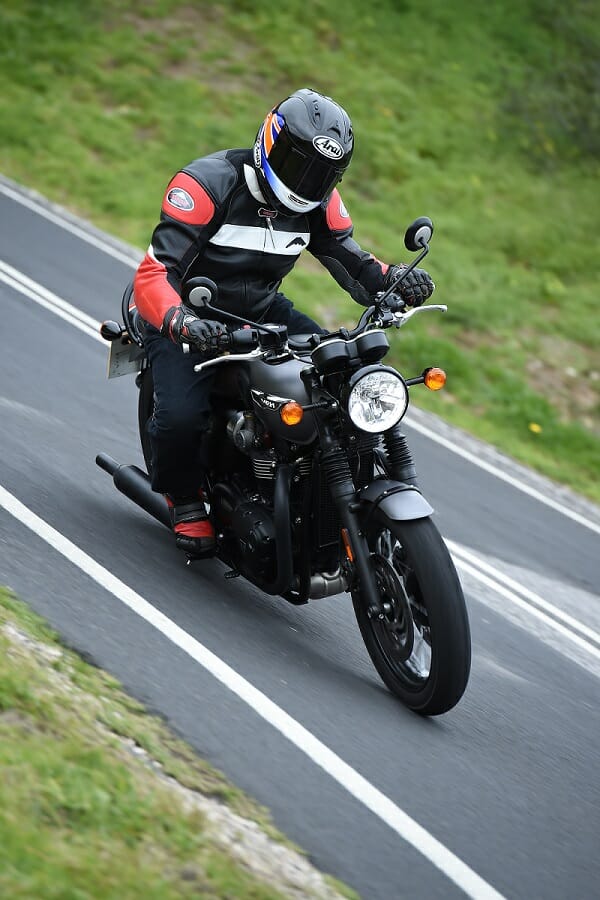
|
SPECIFICATIONS: 2016 Triumph T120 Bonneville |
|
|
ENGINE: |
Liquid-cooled, 8-valve, SOHC, 270° crank angle, parallel twin |
|
DISPLACEMENT: |
1200cc |
|
BORE X STROKE: |
97.6mm x 80mm |
|
COMPRESSION RATIO: |
10.0:1 |
|
MAX POWER: |
79 Bhp (59 kW) @ 6500 rpm |
|
MAX TORQUE: |
105 Nm @ 3100 rpm |
|
FUEL SYSTEM: |
Multipoint sequential electronic fuel injection |
|
EXHAUST: |
2-into-2 exhaust system |
|
EMISSIONS: |
Euro 4 |
|
FUEL CONSUMPTION: |
63 mpg |
|
FINAL DRIVE: |
X-ring chain |
|
CLUTCH: |
Wet, multi-plate assist clutch |
|
TRANSMISSION: |
6-speed |
|
FRAME: |
Tubular steel cradle |
|
SWINGARM: |
Twin-sided, tubular steel |
|
FRONT WHEEL: |
32-spoke, 18 x 2.75 in. |
|
REAR WHEEL: |
32-spoke, 17 x 4.25 in. |
|
FRONT TIRE: |
100/90-18 in. |
|
REAR TIRE: |
150/70-R17 in. |
|
FRONT SUSPENSION: |
Kayaba 41mm cartridge fork |
|
REAR SUSPENSION: |
Kayaba twin shocks with adj. preload |
|
FRONT WHEEL TRAVEL: |
4.7 inches |
|
REAR WHEEL TRAVEL: |
4.7 inches |
|
FRONT BRAKE: |
Twin 310mm discs, Nissin 2-piston floating calipers, ABS |
|
REAR BRAKE: |
Single 255mm disc, Nissin 2-piston floating caliper, ABS |
|
SEAT HEIGHT: |
30.9 in. |
|
WHEELBASE: |
56.9 in. |
|
RAKE/TRAIL: |
25.5°/4.1 in. |
|
DRY WEIGHT: |
493.1 lbs. |
|
FUEL CAPACITY: |
3.3 gal. |
For more Cycle News Standard motorcycle reviews, click HERE.
For more Triumph motorcycle reviews, click HERE.
